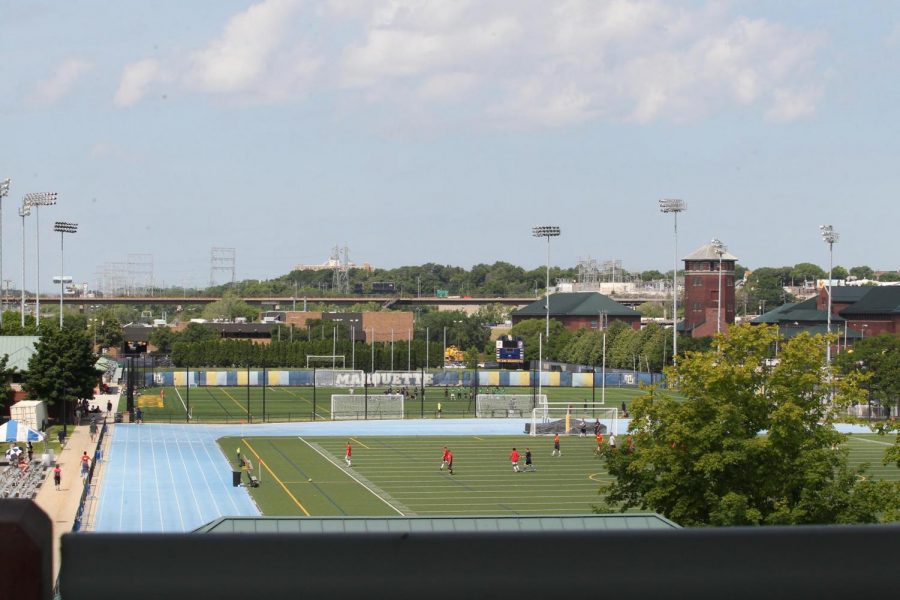Ask men’s soccer head coach Louis Bennett why the team has a home field advantage at Valley Fields, the first thing that comes to mind has nothing to do with proximity to campus, the noise of the Valley crowd or familiar Wisconsin weather.
It’s the grass.
Yes, the grass.
Bennett’s squad has the largest differential between home and overall winning percentage since 2013 among all spectator sports on campus. The impact is quite noticeable.
“(Homefield advantage) exists,” Bennett says. “Unlike the unicorn, that doesn’t exist, home field — when it’s like this — that kind of advantage exists if you know how to use it.”
Men’s soccer center back Manuel Cukaj says the teams feels more comfortable on the grass.
“Valley is looking great right now,” he says.
Analytically, the team’s home field advantage looks better than men’s basketball at Fiserv Forum, and before that, the BMO Harris Bradley Center.
It’s better than women’s basketball at the Al McGuire Center in its run of three consecutive BIG EAST regular season or tournament titles. It’s even better than the volleyball team at the Al McGuire Center that hasn’t missed the NCAA Tournament since 2010.
Marquette is one of two BIG EAST teams to use natural grass as opposed to artificial turf. Georgetown is the other.
It leads to an advantage when turf schools come to Valley and need to adjust to the grass. MU, on the other hand, gets experience on both grass and turf.
“Most of the time they just get that (turf) surface unless they’re on the road somewhere,” women’s soccer head coach Markus Roeders says. “I’m sure there’s a little bit of an adjustment. I think speed of play, maybe the way you strike the ball, just the movement on the grass compared to the turf.”
While the field surface is one of many factors, these two grass schools are responsible for four of the last six BIG EAST men’s soccer titles and five of the last seven BIG EAST women’s soccer titles. Some of those titles have come on their home fields.
The grass creates a softer surface, which gives coaches more comfort when their player goes for a slide tackle or makes a diving play in goal.
“Yes, we slide tackle on the turf, but it’s definitely not as consistent as when we do it on the grass,” Roeders explains. “If you ask any goalkeeper, they would tell you like, ‘Hey, get me on grass 10 out of 10 times before you get me on turf.’”
It’s not just slide tackles or goalkeepers’ dives, Bennett says.
“The twisting and turning is not the same on grass. If you twist or turn the wrong way, you fall on the grass and mud,” Bennett explains. “If you do it on turf, you fall on a hard surface.”
Bennett likes the field wet and cut very short, so the sprinkler system turns on pregame and at halftime, creating a surface that “replicates the ball rolling (similar to a professional field).”
“We’d prefer to have it slick so the ball moves fast,” Bennett says.
Not all of the benefits of a grass field come on game day, Bennett and Roeders say. When recruits come in, a high-quality grass field can be a major selling point, especially in warmer climates. Many schools in warmer climates have Bermuda grass, which is softer and does not need as much water.
“We want someone to come from down south where they’re playing on grass and they’re playing on Bermuda grass,” Bennett says. “We want to make sure people know this is a great surface to play on.”
Valley’s grass surface is a way of competing with nearby rivals who Bennett describes as “noisy neighbors” since many of the top teams in the world and in the collegiate game use grass fields.
“All the top players in the world have no problem playing on grass,” Bennett says. “Some of the top players in the world have a huge problem playing on artificial turf.”
It is also one of the reasons for Bennett left the turf field at University of Wisconsin-Milwaukee to take the same job at Marquette in 2005.
“(UWM’s field) is an unbelievably tricky surface,” Bennett says. “You know what you’re getting (at Valley Fields).”
At the same time, the soccer teams practice on an adjacent turf field year-round. A seasonal dome at Valley allows the teams to practice, even when it’s otherwise too cold to play soccer in Milwaukee.
“In the Marquette Gymnasium, you couldn’t strike the ball further than 20 yards, and if you did that, it was probably bouncing off the walls,” Roeders says. “Now we can play a full spring game in the middle of February without any restrictions.”
Other schools have found ways to make sure their turf fields allow the ball to move quickly. Creighton, for instance, uses water cannons to submerge the turf in water, Bennett says.
Bennett and Roeders, whom Roeders admits are “traditionalists,” will not be giving up Valley’s coveted grass any time soon.
“Grass is the ultimate thing to play on,” Bennett says.

